Project Batch: Second Batch of 2021
Project Number: 202102278057
Project Type: New Engineering Construction Project
Background of Project Implementation
HarmonyOS is a next-generation smart terminal operating system that provides a unified language for the intelligence, interconnection, and collaboration of different devices, delivering a concise, smooth, secure, continuous, and reliable interactive experience across all scenarios. Compared to Android and embedded Linux systems, HarmonyOS is not just a single system for a mobile phone or a specific device; it is a general-purpose system that can interconnect all devices, giving it a significant advantage in the Internet of Things (IoT) systems.
Central China Normal University offers courses such as “Microcontroller Technology and Applications,” “Operating System Principles,” and “Embedded Operating Systems” for students in the IoT Engineering, Software Engineering, and Computer Science programs. In addition to principles, the course content primarily focuses on teaching systems like Linux and Android. As IoT and AIoT rapidly advance, these systems have gradually revealed some shortcomings. The characteristics of HarmonyOS, which align with the 1+8+N concept in the context of universal interconnection, better meet future needs.
The current curriculum system and training program primarily support embedded operating system-related knowledge through courses like “Microcontroller Technology and Applications,” “Operating System Principles,” “Embedded Systems,” and “Web Programming Technology,” among others.
Reform Ideas and Measures
1. Main Idea: Promote HarmonyOS technology and applications in the course content to break the long-standing dependence on foreign products in operating systems.
Specific Measures:
1. Prioritize course content that selects software and hardware technology systems developed by domestic high-tech enterprises like Huawei.
2. Prioritize open-source software and hardware technology in course content. While selecting hardware systems compatible with HarmonyOS, we also chose the Hi3861 core board with the open-source RISC-V core SOC chip produced by Huawei HiSilicon, along with the Pegasus IoT kit and smart car kit.
2. Main Idea: Focus on fundamentals and low-cost investment to quickly cultivate interdisciplinary new engineering talents in the fields of IoT engineering, software engineering, computer networks, and computer science and technology.
Specific Measures:
1. Emphasize Fundamental Content. The technology related to HarmonyOS cannot be fully covered by a single course. In terms of course content selection, we prioritize fundamental aspects of the relevant technologies. For example, in the microkernel content, we cover basic functions of the microkernel, including task management, memory management, basic IPC functions, soft timers, and other foundational operating system functions; in terms of device development interfaces, we prioritize widely used and fundamental interfaces like GPIO, I2C, and PWM. In application development choices, we emphasize basic programming skills, fundamental application architecture, and interface development controls.
Additionally, key function features in system software strive to trace back to the implementation of CPU assembly programs; software functions related to hardware interfaces are explained in conjunction with hardware functionalities.
2. Course Content Focused on Low-Cost Investment. The course content emphasizes low-cost investments, with specific methods including: using software simulators when learning the basic functions of the LiteOS microkernel without the need for experimental boxes or development boards; using simulators or remote real devices provided by Huawei for learning HarmonyOS application UI development; and using the Hi3861 core board costing under a hundred yuan for OpenHarmony device development.
3. Accelerate Talent Cultivation. The knowledge involved in the embedded operating systems course covers multiple courses and disciplines, and according to previous training programs, it would take a long time to complete these courses. This project focuses on accelerating the talent cultivation process by integrating the necessary course content into a single course, discarding content from the original training program that is no longer suitable, and speeding up the training process.
Specific measures include: course content encompassing the basic principles of operating systems (such as task management and memory management); course content including principles and basic operational processes of the I2C bus; course content covering the basic syntax of development languages like HTML, CSS, JS, and TypeScript, etc.
4. Main Idea: Obtain a complete set of teaching resources based on HarmonyOS-related courses.
Specific Measures:
1. Compile Textbooks. At the time of project construction, there were no suitable reference books available, so we began compiling reference textbooks “Basics of HarmonyOS IoT Development” and “Practical Basics of HarmonyOS IoT Development” (published in 2023) to provide basic conditions for the smooth progress of the course.
2. Create Teaching Slides. The project provided basic PowerPoint slides and web-version slides that correspond to the content of the reference books required for the course.
3. Provide Sample Code. The project provided sample code for demonstration during the teaching process.
4. Other Teaching Resources. This project course provided exercises and answers, teaching outlines, teaching schedules, and other necessary resources.
Project Achievements, Innovations, and Effectiveness
1. Project Achievements and Innovations
1. Deeply integrated concept of industry-university cooperation. The project firmly implements the concept of deep integration of industry-university cooperation, and the course content set by the project can fully replace previous content. According to project requirements, we compiled and published the “Basics of HarmonyOS IoT Development” and “Practical Basics of HarmonyOS IoT Development” book series. This series includes foundational knowledge of microkernels, lightweight device development, and application UI development, with comprehensive content that balances theory and practice, strongly integrating with the course.
2. Adaptation to new engineering, transformation of course knowledge structure. In the context of new engineering, where new technologies emerge continuously, the original course system structure needs transformation. The previous course knowledge points were numerous, and some were no longer suitable for technological progress. This course extracts related knowledge points from relevant courses and reorganizes them into new course content, adapting to the requirements of new engineering. These transformations are reflected in the “Basics of HarmonyOS IoT Development” and “Practical Basics of HarmonyOS IoT Development” book series, as well as in the teaching outline and teaching calendar of the course.
3. Advanced concept of industry-university cooperation. The course content reflects new technologies and trends in the industry. The project selects HarmonyOS, which embodies the 1+8+N concept in the context of universal interconnection, as the teaching content, better reflecting new technologies in the industry. At the same time, HarmonyOS is suitable for various types of devices, making it a new trend for the future.
4. Emphasis on ideological and political factors. This project itself emphasizes ideological and political factors. The course content primarily selects teaching materials developed by Huawei, which helps to cultivate students’ patriotism and enhance their national pride and confidence.
5. Sustainability concept. The sustainability concept runs throughout this project. After the project concluded in early 2023, as an extension of the project, the course content developed has been continuously promoted, including: from late June to early July 2023, conducting practical training for graduation projects at Wuhan Engineering University on HarmonyOS all-scenario applications; in August 2023, a live broadcast of course content was conducted on Tsinghua University’s Science and Technology Public Account; in April 2024, teacher training was conducted based on this course content in the “Advanced Training Course for Computer Courses in Colleges and Universities (2024 Third Session)”; and in the “2024 IoT Education Summit Forum,” course content was exchanged.
6. Comprehensive teaching resources. Through this project, rich teaching resources have been formed, including the compiled reference books “Basics of HarmonyOS IoT Development” and “Practical Basics of HarmonyOS IoT Development,” teaching outlines, teaching PPTs, exercises and answers, sample code, etc., meeting the requirements for rapid implementation of the course.
7. Concept of comprehensive ability cultivation. The project emphasizes the comprehensive ability cultivation of students, encouraging them to participate in academic competitions, providing related graduation project topics, and participating in professional certification. Among these, the works of our school’s “ICT Team Charge” which won the special prize in the global finals of the 8th Huawei ICT Competition and the works of our school’s “Tata Jianghuo” team, which won the special prize in this national finals, both applied technologies related to this course. Some students obtained the OpenAtom OpenHarmony Talent Certification through their studies. In the past two years, there have been undergraduate students completing graduation theses related to HarmonyOS.
2. Project Effectiveness
Talent Cultivation: 30 students enrolled in this course, 7 students based their graduation theses on this project content, 3 student teams received awards of second prize or above in the Huawei ICT Competition Innovation Contest, and 3 students published technical articles on Tsinghua University’s Computer Academy Public Account.
Teacher Training: Teacher training based on this project content was conducted for 42 teachers from 26 universities across 7 provinces and cities.
Professional Qualification Certification: Over 50 individuals obtained OpenAtom OpenHarmony certification through this course.
Application and Promotion Status
1. Course Offerings at Our University
In 2021 and 2023, the “Embedded Operating Systems” course was offered to undergraduates at our university, with students from IoT Engineering, Software Engineering, and Information Security majors. The learning content, assessment content, and project content of the course are highly aligned. The course has been well received by students, with an evaluation score of 93.
2. Student Cultivation at Our University
In addition to course study, some students further completed graduation theses, such as the 2023 undergraduate thesis “Development of Smart Farm Equipment Based on HarmonyOS,” and the 2024 undergraduate theses “Design and Implementation of Open Source Harmony Weather Forecast Software” and “Design and Development of Noise Monitoring System Based on HarmonyOS”; some students participated in academic competitions and received awards, such as the second prize in the national finals of the “Huawei ICT Competition 2021” Innovation Contest. Excellent student works, such as “E-Art Simple Electronic Art Appreciation App – Simple Prototype Developed Based on ArkTS Declarative UI” and “HarmonyOS Noise Monitoring APP Design and Development” were published on Tsinghua University’s Computer Academy Public Account.
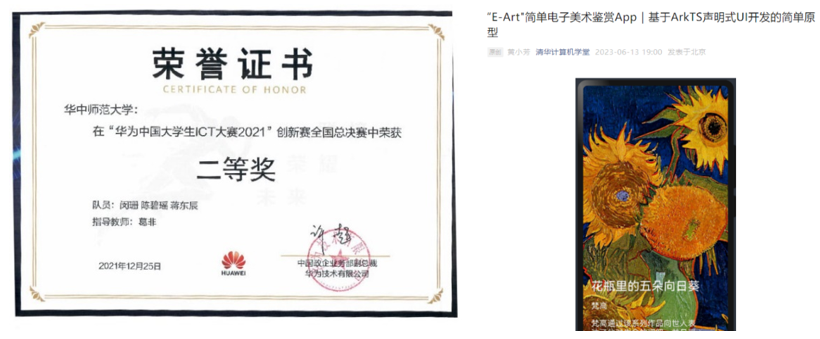
3. Off-Campus Student Cultivation
The project content was utilized in the graduation internship training for HarmonyOS all-scenario application development at Wuhan Engineering University in 2023. Through this training, over 70 students majoring in IoT learned many technologies related to HarmonyOS and were able to develop IoT applications like smart lamps on the “All-Scenario HarmonyOS Innovation Development Experiment Box” from Boshai Network.
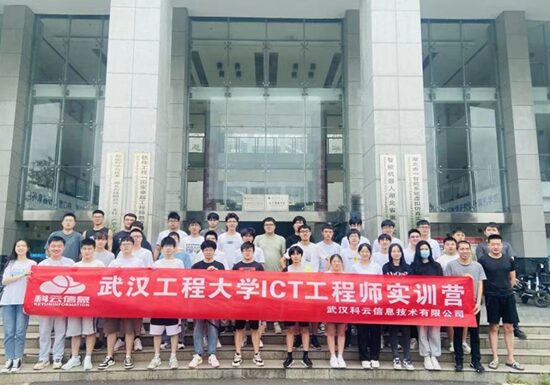
4. Teacher Training
In the “Advanced Training Course for Computer Courses in Colleges and Universities (2024 Third Session),” a course titled “Basics of IoT Development Based on OpenHarmony” was offered, recruiting 50 teachers, with 42 teachers signing in from 26 universities covering 7 provinces and cities in Beijing, East China, and Central China.
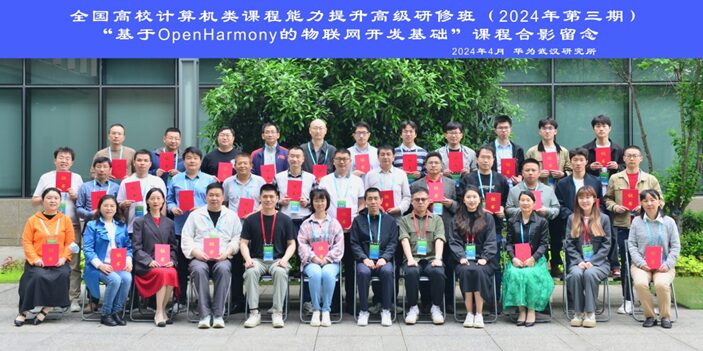
5. IoT Education Summit Forum
Participated in the 4th IoT Education Summit Forum held at Jiangnan University from May 31 to June 2, 2024, and presented a report titled “Teaching Reflections on the Undergraduate Course ‘Embedded Operating Systems.'” The report covered experiences and reflections on the application of OpenHarmony training content in related IoT professional teaching.
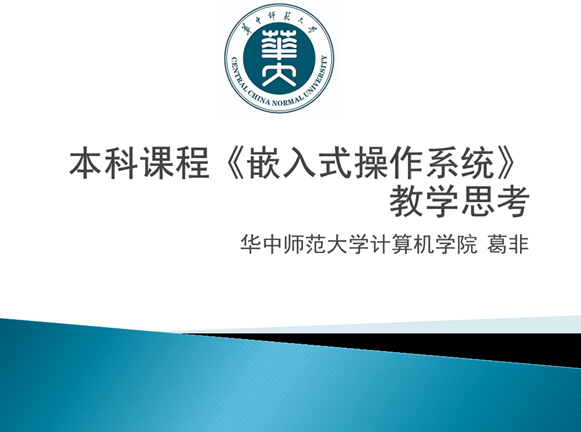
6. Book Sales
Since the publication of “Practical Basics of HarmonyOS IoT Development” in February 2023 and June 2023, it has been printed 3 times for a total of 2500 copies, while “Basics of HarmonyOS IoT Development” has been printed 2 times for a total of 1800 copies.
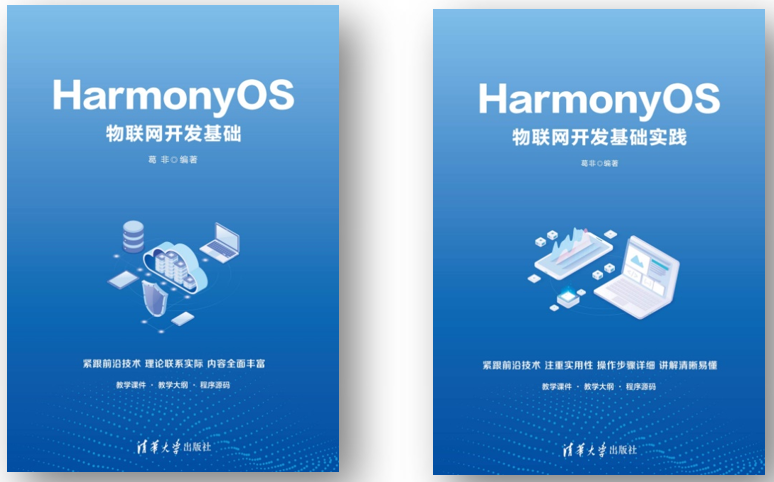
7. Professional Certification
Teachers participating in the training and some undergraduate students from our university obtained the OpenAtom OpenHarmony certification after studying and passed the exam.
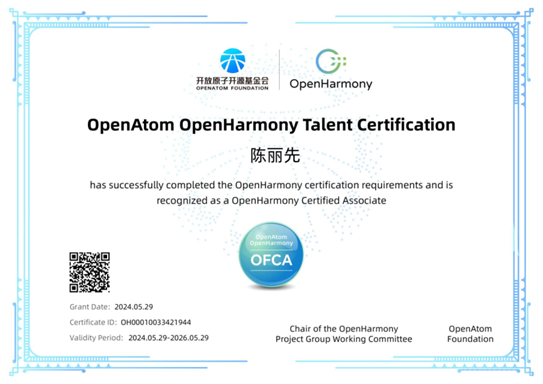
8. Online Promotion
In August 2023, part of the course content was live-streamed on Tsinghua University’s Science and Technology Public Account and won the “Most Popular Live Broadcast Award” from Tsinghua University Press for 2023.
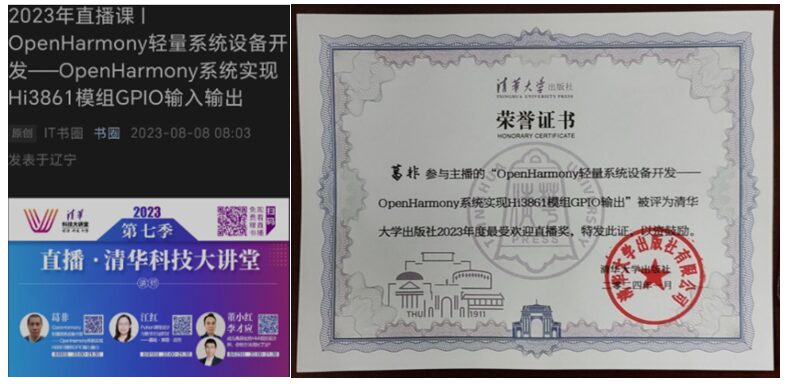
9. Others
The project concluded excellently, winning the Huawei Excellent Achievement Award for the Ministry of Education’s Industry-University Cooperation Collaborative Education Project in 2023, and the person in charge received the title of “Outstanding Teacher in the Field of Harmony Ecosystem University Talent” for 2023.
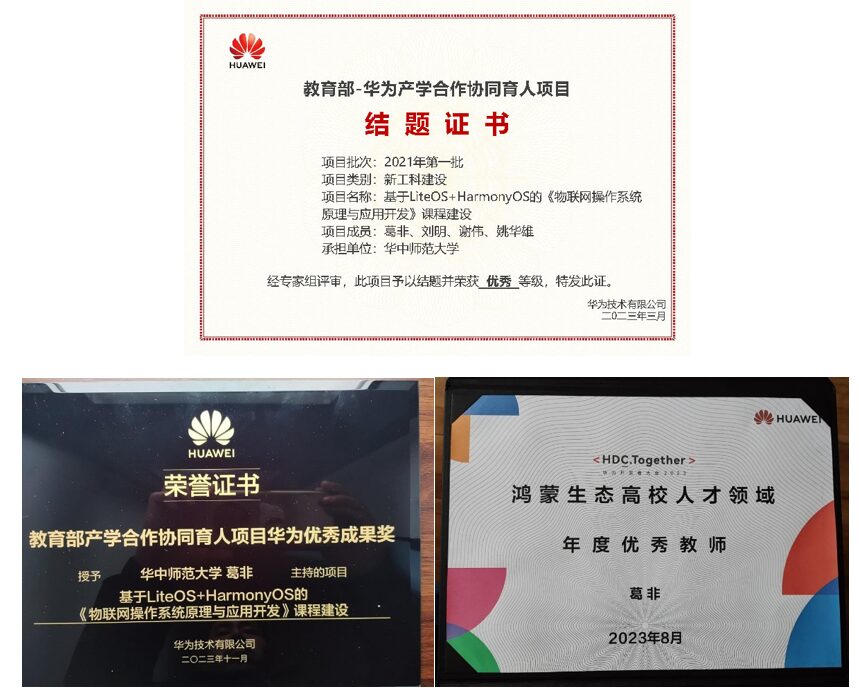
Experience Summary
1. Some Experiences
1. New engineering project content should have technological advancement. HarmonyOS is an operating system with independent intellectual property rights that has emerged in recent years, possessing several advanced features. Data from May 2024 shows that over 800 million devices run HarmonyOS, indicating its strong competitiveness. This project brings industry-leading technology into the classroom, narrowing the gap between classroom knowledge and enterprise technology, which is the most significant experience of this project’s success.
2. Projects should accelerate the cultivation of new engineering talents. This project involves knowledge from multiple courses and disciplines, necessitating selection in the teaching content, requiring integration of related course content into a single course, discarding content from the original training program that is no longer suitable, and accelerating talent cultivation.
2. Next Steps
The course can be further adjusted to face future demands. One adjustment direction is to increase the development technology for small systems and standard systems tailored to different device needs; another adjustment direction is to incorporate advanced application content into the course, such as AI capabilities at the IoT edge.